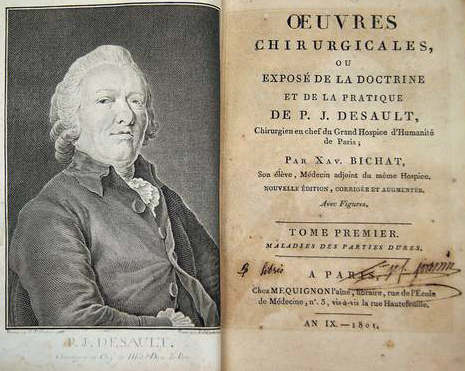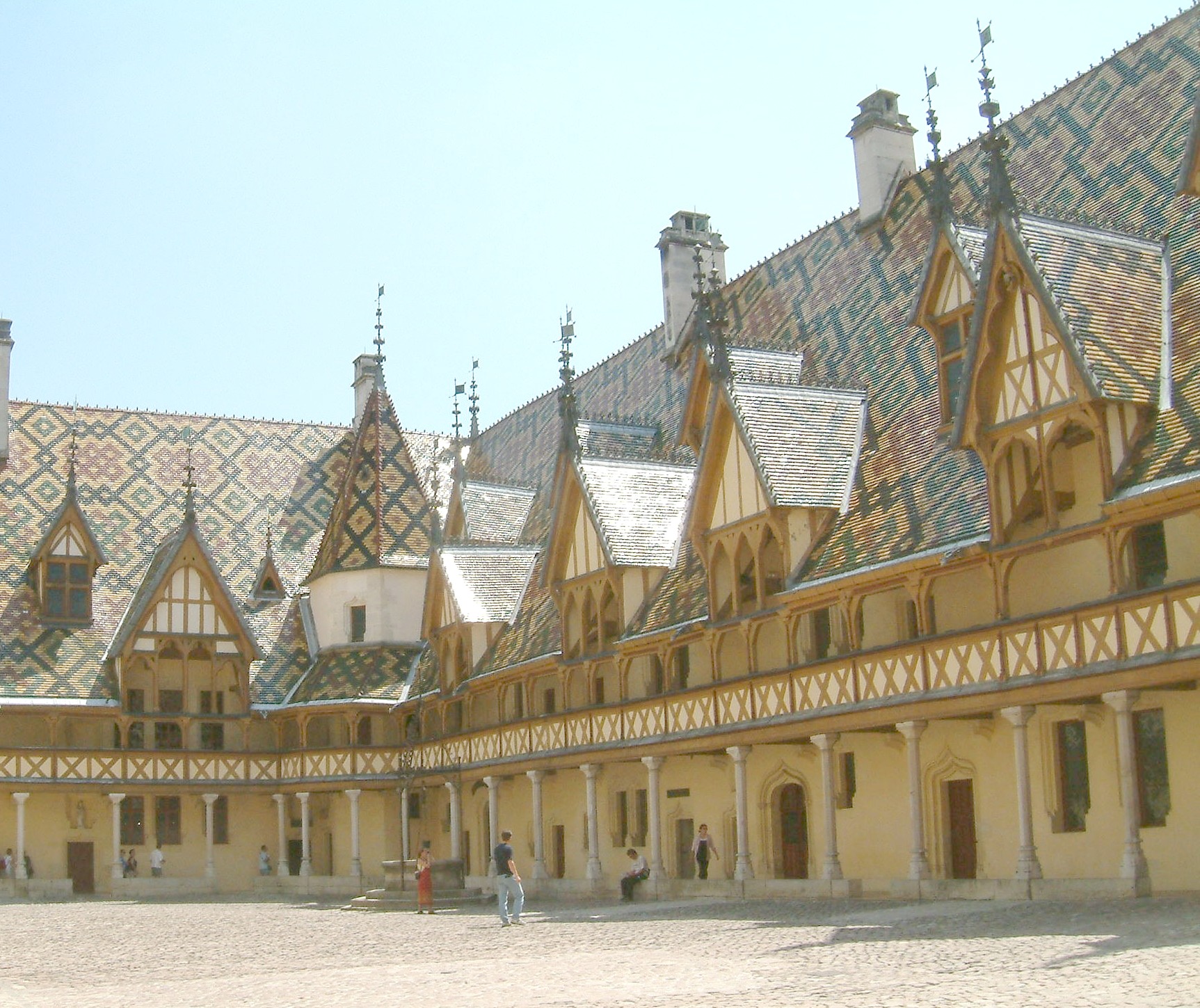|
Dominique-Jean Larrey
Baron Dominique Jean Larrey (; 8 July 1766 – 25 July 1842) was a French surgeon and military doctor, who distinguished himself in the French Revolutionary Wars and the Napoleonic Wars. An important innovator in battlefield medicine and triage, he is often considered the first modern military surgeon. Early life and career Larrey was born in the little village of Beaudéan, in the Pyrenees as the son of a shoemaker, who later moved to Bordeaux. He was orphaned at the age of 13, and was then raised by his uncle Alexis, who was chief surgeon in Toulouse. After an 8-year apprenticeship, he went to Paris to study under Pierre-Joseph Desault, who was chief surgeon at the Hôtel-Dieu de Paris. Larrey then went to Brest, where he was appointed surgeon in the navy and began lecturing. In 1787 he boarded a ship deployed to the defense of Newfoundland, and was, at nearly 21 years-old at the time, the youngest medical officer in the French Royal Navy. While in America, Larrey took an inter ... [...More Info...] [...Related Items...] OR: [Wikipedia] [Google] [Baidu] |
Nobility Of The First French Empire
As Emperor of the French, Napoleon I created titles of nobility to institute a stable elite in the First French Empire, after the instability resulting from the French Revolution. Like many others, both before and since, Napoleon found that the ability to confer titles was also a useful tool of patronage which cost the state little treasure. In all, about 2,200 titles were created by Napoleon: * Princes and Dukes: **Princes of the Imperial family ***The Imperial Prince (Napoleon's son, Napoleon II) ***Princes of France (8 close family members) ** sovereign princes (3) ** duchies grand fiefs (20) ** victory princes (4) ** victory dukedoms (10) ** other dukedoms (3) * Counts (251) * Barons (1,516) * Knights (385) Napoleon also established a new knightly order in 1802, the Légion d'honneur, which is still in existence today. The Grand Dignitaries of the French Empire ranked, regardless of noble title, immediately behind the Princes of France. Creation Ennoblement started in 18 ... [...More Info...] [...Related Items...] OR: [Wikipedia] [Google] [Baidu] |
Bordeaux
Bordeaux ( , ; Gascon oc, Bordèu ; eu, Bordele; it, Bordò; es, Burdeos) is a port city on the river Garonne in the Gironde department, Southwestern France. It is the capital of the Nouvelle-Aquitaine region, as well as the prefecture of the Gironde department. Its inhabitants are called ''"Bordelais"'' (masculine) or ''"Bordelaises"'' (feminine). The term "Bordelais" may also refer to the city and its surrounding region. The city of Bordeaux proper had a population of 260,958 in 2019 within its small municipal territory of , With its 27 suburban municipalities it forms the Bordeaux Metropolis, in charge of metropolitan issues. With a population of 814,049 at the Jan. 2019 census. it is the fifth most populated in France, after Paris, Lyon, Marseille and Lille and ahead of Toulouse. Together with its suburbs and exurbs, except satellite cities of Arcachon and Libourne, the Bordeaux metropolitan area had a population of 1,363,711 that same year (Jan. 2019 census), ma ... [...More Info...] [...Related Items...] OR: [Wikipedia] [Google] [Baidu] |
Storming Of The Bastille
The Storming of the Bastille (french: Prise de la Bastille ) occurred in Paris, France, on 14 July 1789, when revolutionary insurgents stormed and seized control of the medieval armoury, fortress, and political prison known as the Bastille. At the time, the Bastille represented royal authority in the centre of Paris. The prison contained only seven inmates at the time of its storming, but was seen by the revolutionaries as a symbol of the monarchy's abuse of power; its fall was the flashpoint of the French Revolution. In France, 14 July is a national holiday, usually called Bastille Day in English. However, the expression Bastille Day is properly incorrect, as the event celebrated during the national holiday is the Fête de la Fédération of 1790, which was itself the 1st anniversary of the Bastille Day. Background During the reign of Louis XVI France faced a major economic crisis. This crisis was caused in part by the cost of intervening in the American Revolution and exacer ... [...More Info...] [...Related Items...] OR: [Wikipedia] [Google] [Baidu] |
Les Invalides
The Hôtel des Invalides ( en, "house of invalids"), commonly called Les Invalides (), is a complex of buildings in the 7th arrondissement of Paris, France, containing museums and monuments, all relating to the military history of France, as well as a hospital and a retirement home for war veterans, the building's original purpose. The buildings house the Musée de l'Armée, the military museum of the Army of France, the Musée des Plans-Reliefs, and the Musée d'Histoire Contemporaine. The complex also includes the former hospital chapel, now national cathedral of the French military, and the adjacent former Royal Chapel known as the , the tallest church building in Paris at a height of 107 meters. The latter has been converted into a shrine of some of France's leading military figures, most notably the tomb of Napoleon. History Louis XIV initiated the project by an order dated 24 November 1670, as a home and hospital for aged and disabled () soldiers. The initial arch ... [...More Info...] [...Related Items...] OR: [Wikipedia] [Google] [Baidu] |
Raphaël Bienvenu Sabatier
Raphaël Bienvenu Sabatier (11 October 1732 – 19 July 1811) was a French anatomist and surgeon born in Paris. He studied medicine in Paris, and in 1756 became a professor at the Collège Royal de Chirurgie. Shortly afterwards, he became chief surgeon at the Hôtel des Invalides, and in 1795 was a professor at the École de Santé. Sabatier was a member of the French Academy of Sciences, and was a consultant-surgeon to Napoleon Bonaparte. Sabatier was the author of ''De la médecine opératoire'', a popular surgical treatise in its day, and ''Traité complet d'anatomie'', a three-volume work on anatomy. He was an early practitioner of medical percussion, a procedure he used in the diagnosis of empyema. @ |
Xavier Bichat
Marie François Xavier Bichat (; ; 14 November 1771 – 22 July 1802) was a French anatomist and pathologist, known as the father of modern histology. Although he worked without a microscope, Bichat distinguished 21 types of elementary tissues from which the organs of the human body are composed. He was also "the first to propose that tissue is a central element in human anatomy, and he considered organs as collections of often disparate tissues, rather than as entities in themselves". Although Bichat was "hardly known outside the French medical world" at the time of his early death, forty years later "his system of histology and pathological anatomy had taken both the French and English medical worlds by storm." The Bichatian tissue theory was "largely instrumental in the rise to prominence of hospital doctors" as opposed to empiric therapy, as "diseases were now defined in terms of specific lesions in various tissues, and this lent itself to a classification and a list of dia ... [...More Info...] [...Related Items...] OR: [Wikipedia] [Google] [Baidu] |
Jean-Nicolas Corvisart
Jean-Nicolas Corvisart-Desmarets (15 February 1755 – 18 September 1821) was a French physician. Born in the village of Dricourt (now in Ardennes), Corvisart studied from 1777 at the Ecole de Médecine in Paris, later qualifying as ''docteur régent'' of the Faculté de Paris (1782).Napoleon.org Corvisart, Jean-Nicolas (1755–1821), Physician to the Emperor In 1797, Corvisart began to teach at the , where he gained a reputation as an expert in . Among his students were |
Mores
Mores (, sometimes ; , plural form of singular , meaning "manner, custom, usage, or habit") are social norms that are widely observed within a particular society or culture. Mores determine what is considered morally acceptable or unacceptable within any given culture. A folkway is what is created through interaction and that process is what organizes interactions through routine, repetition, habit and consistency. William Graham Sumner (1840–1910), an early United States of America, U.S. sociologist, introduced both the terms "mores" (1898) and "folkways" (1906) into modern sociology. Mores are strict in the sense that they determine the difference between right and wrong in a given society, people may be punished for their immorality which is common place in many societies in the world, at times with disapproval or ostracizing. The main examples of traditional customs and conventions that are mores may include; lying, cheating, harm, causing harm, sobriety, alcohol use, i ... [...More Info...] [...Related Items...] OR: [Wikipedia] [Google] [Baidu] |
Newfoundland
Newfoundland and Labrador (; french: Terre-Neuve-et-Labrador; frequently abbreviated as NL) is the easternmost province of Canada, in the country's Atlantic region. The province comprises the island of Newfoundland and the continental region of Labrador, having a total size of 405,212 square kilometres (156,500 sq mi). In 2021, the population of Newfoundland and Labrador was estimated to be 521,758. The island of Newfoundland (and its smaller neighbouring islands) is home to around 94 per cent of the province's population, with more than half residing in the Avalon Peninsula. Labrador borders the province of Quebec, and the French overseas collectivity of Saint Pierre and Miquelon lies about 20 km west of the Burin Peninsula. According to the 2016 census, 97.0 per cent of residents reported English as their native language, making Newfoundland and Labrador Canada's most linguistically homogeneous province. A majority of the population is descended from English and Irish s ... [...More Info...] [...Related Items...] OR: [Wikipedia] [Google] [Baidu] |
Brest (France)
Brest (; ) is a port city in the Finistère department, Brittany. Located in a sheltered bay not far from the western tip of the peninsula, and the western extremity of metropolitan France, Brest is an important harbour and the second French military port after Toulon. The city is located on the western edge of continental France. With 142,722 inhabitants in a 2007 census, Brest forms Western Brittany's largest metropolitan area (with a population of 300,300 in total), ranking third behind only Nantes and Rennes in the whole of historic Brittany, and the 19th most populous city in France; moreover, Brest provides services to the one million inhabitants of Western Brittany. Although Brest is by far the largest city in Finistère, the ''préfecture'' (regional capital) of the department is the much smaller Quimper. During the Middle Ages, the history of Brest was the history of its castle. Then Richelieu made it a military harbour in 1631. Brest grew around its arsenal until t ... [...More Info...] [...Related Items...] OR: [Wikipedia] [Google] [Baidu] |
Hôtel-Dieu De Paris
In French-speaking countries, a hôtel-Dieu ( en, hostel of God) was originally a hospital for the poor and needy, run by the Catholic Church. Nowadays these buildings or institutions have either kept their function as a hospital, the one in Paris being the oldest and most renowned, or have been converted into hotels, museums, or general purpose buildings (for instance housing a préfecture, the administrative head office of a French department). Therefore, as a secondary meaning, the term hôtel-Dieu can also refer to the building itself, even if it no longer houses a hospital. Examples include: ;Belgium * Notre Dame à la Rose, founded in 1242 ;France *Hôtel-Dieu d'Angers, founded in 1153 *Hôtel-Dieu de Beaune, founded in 1443 *Hôtel-Dieu of Carpentras, built in 1754 *Hôtel-Dieu of Château-Thierry, founded in 1304 *Hôtel-Dieu of Cluny, built in the 17th and 18th century *Hôtel-Dieu de Lyon, created in 1478 *Hôtel-Dieu of Nantes, completed in 1508 *Hôtel-Dieu de Paris, fo ... [...More Info...] [...Related Items...] OR: [Wikipedia] [Google] [Baidu] |







